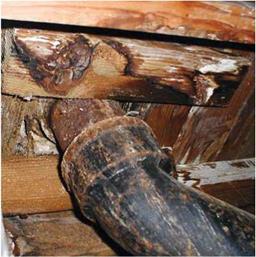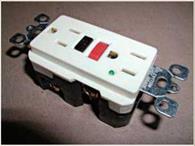FLOORS AND STAIRS
Squeaky floors may take 2 minutes to repair or 2 days, when the cause is elusive. If you can live with some squeaks, they’re rarely a sign of anything serious.
Excessively springy floors suggest subflooring or underlayment that’s not strong enough to span the joists. Additional layers of subflooring or flooring should firm things up.
Deteriorating flooring near an exterior door – sill suggests that rain or snow has soaked the sill and subflooring. You’ll need to replace damaged materials and install an all-weather doorsill.
Widespread cracking in tile floors may result from insufficient adhesive between tile and subflooring or an underlayment that’s too thin and thus not rigid enough. Repairing it may mean tearing out the tile and perhaps the underlay – ment before replacing both.
Cracked stair treads may be worn, undersize, or inadequately supported by the carriages
|
The water damage and rot beneath this toilet could have been avoided by replacing a $2 wax gasket. |
|
|
underneath. If the problem is widespread, remove the treads and examine the substructure.
Stairs sloping badly to one side, with cracked walls along the stair suggest a stair carriage that is pulling loose from wall mountings or other framing members. If the underside of the stairs is not accessible, repairing the problem can be complex and costly.
Handrails and newel posts that wobble more than h in. should be resecured. If balusters are missing, it can be costly to have replacements hand-turned to match. As a cost-saving alternative, you might be able to find replacements at a salvage yard.
If there are stained, springy floors around the base of a toilet, the subfloor and the joists below may be water damaged. The cause of the leak may be simple—just a worn-out wax ring gasket under the toilet. But if damage is significant, you may need to pull up flooring and replace it.
Damaged linoleum or vinyl around cabinets, shower stalls, or tubs often foretells water damage below. If there’s an unfinished basement beneath those fixtures, inspect there for damage. Otherwise, look for water damage in finished ceilings below.
If tiled tub enclosures are in poor repair, test the firmness of the substrate behind by pushing with the heel of your hand. If the walls flex, the tile may be installed over ordinary drywall, which deteriorates if it absorbs water. One remedy is tearing out the tile and drywall and installing a cement-based backer board before retiling.
Check tub-wall joints closely. They must be well caulked to forestall leaks.
![]()
 Use your pocketknife to prod for damage under lavatory and kitchen sink cabinets. Rusted – out drainpipes or leaking supply-pipe connections are easily replaced, but extensive water damage can be costly to remedy.
Use your pocketknife to prod for damage under lavatory and kitchen sink cabinets. Rusted – out drainpipes or leaking supply-pipe connections are easily replaced, but extensive water damage can be costly to remedy.
|
|
|
PIPE LIFE AND Water QUALITY |
If supply pipes are galvanized steel, their useful life is about 25 years. Copper supply pipes installed before 1990 may contain lead in solder joints, which can leach into drinking water. So before making an offer, get the water tested for lead and other toxins. If the pipes appear to be otherwise in good condition, an in-line filtration system with replaceable filters may be a cost-effective solution to this problem.
If bathrooms or kitchens smell musty or are mildewed, especially at the top of walls, there’s inadequate ventilation. Scrubbing walls and adding vent fans will probably cure the problem, unless the drywall is crumbling (see Chapter 14 for repair information).
Safety note: Stay out of basements or crawl spaces if there’s standing water, wet soil, or substandard electrical wiring! Metal pipes or ductwork could become energized by a short circuit.
Dampness can be mitigated by gutters and downspouts, as well as a ground surface that slopes away from the house. Musty smells and mild mold can usually be reduced by improving ventilation. Beyond that, fixes get more complex and more expensive.
Wetness is often caused by surface water and may respond to the remedies mentioned in the preceding paragraph. Stronger remedies include sump pumps, perimeter drains, and engineered solutions. For example, water seeping through an uphill foundation wall may need to be intercepted and rerouted by drainpipes or swale drains farther uphill. Solutions can become expensive.








Leave a reply